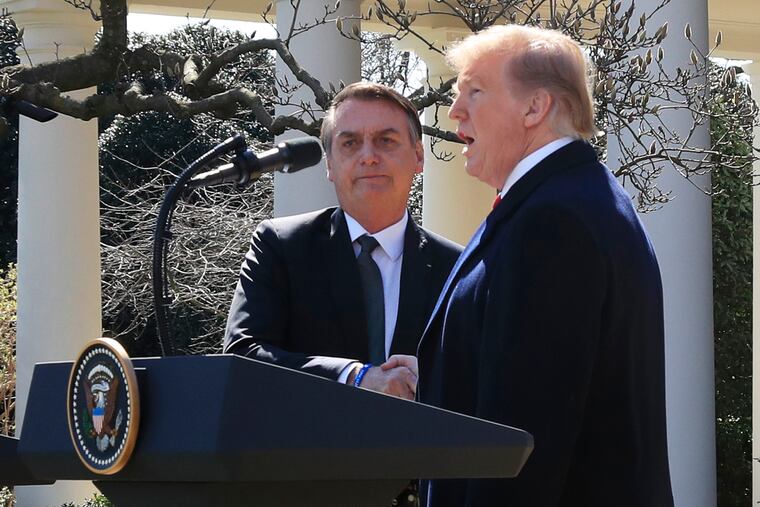America now inspires world for wrong reasons: Nationalism, conspiracy theories, and attacks on press | Trudy Rubin
Trump's promotion of autocrats, conspiracy theories and attacks on press has transformed America from role model for democracy to inspiration for virulent populists.

The mass murderer of 51 worshipers in New Zealand mosques last week issued a manifesto in which he asked himself this question: "Were/are you a supporter of Donald Trump?”
His answer: “As a symbol of renewed white identity and common purpose? Sure. As a policy maker and leader? Dear god no.”
In other words, there was no linear connection between Trump and the New Zealand massacre, nor can he be directly blamed for the carnage. Yet Trump has become an important symbol for white nationalists and bigots in America, and for autocrats worldwide.
The New Zealand tragedy is only the latest illustration.
The United States, which inspired would-be democrats abroad for decades, is now led by a president who inspires anti-democratic movements. Look no further than his response to the New Zealand tragedy for the latest illustration of this dangerous trend. When asked if he viewed white nationalism as a rising global threat, Trump replied: “I don’t really. I think it’s a small group of people....”
The president studiously ignores statistics from respected U.S. groups that track extremism. According to the New York-based Anti-Defamation League (ADL), there was a 182 percent increase in white supremacist propaganda incidents in the last year, with 1,187 cases reported, compared with 421 in 2017. At least 91 white supremacist rallies were held in 2018, up from 76 the previous year.
The ADL also says that in the U.S. in 2018, “every single extremist killing — from Pittsburgh to Parkland — had a link to right-wing extremism.” There were 50 such murders.
Add to that, the Southern Poverty Law Center, a diligent tracker of far-right extremists, says the U.S. had more hate groups last year than at any time in the last two decades, with “a 30 percent increase with Trump’s campaign and presidency.”
Get the trend?
Yet rather than denounce far-right bigotry after the New Zealand slaughter, Trump tweeted a storm of support for Judge Jeanine Pirro, who was briefly suspended by Fox News for anti-Muslim slurs. He retweeted kooky far-right Trumpsters who promote the crazy QAnon conspiracy theory detailing a secret plot by an alleged “deep state” against him.
Just before New Zealand, he told far-right Breitbart News that he had “the support of the police, the support of the military, the support of the Bikers for Trump,” to play it tough against his opponents if need be, and "then it would be very bad, very bad.”
His fact-free tweets about “stolen elections” hint at future incitement to violence should he lose in 2020. A further yellow light to violent extremists.
Of course, we have become inured to this behavior from a president who famously insisted some neo-Nazis at the torch-lit parade in Charlottesville, Va., were “fine people.” No need to reprise his support of the “birther” lies about President Barack Obama, or his racist comments about immigrants.
But experts on extremism warn against downplaying the impact of the president’s words in egging on extremists.
“It modifies what is considered permissible,” says Harvard’s Steven Levitsky, co-author of How Democracies Die. “Trump is defining deviancy down, and things thought unimaginable are suddenly imaginable. A congressman body-slams a reporter, and this is praised by the U.S. president. That shapes opinion.”
Warns the ADL’s deputy national director, Kenneth Jacobson: “For a long time, the view was that [right-wing extremists] were a few extreme kooks. It’s not clear their numbers are growing substantially, but there is the growing sense that this is their moment and they may be able to act things out.”
Rather than stem the tides of far-right extremism, Trump drives them higher like a bright new moon.
The president has also become a lodestar for anti-democratic leaders and movements in Europe, Latin America, and Asia. We’ve gotten used to his fulsome praise for Russia’s Vladimir Putin, China’s Xi Jinping, and North Korea’s Kim Jong Un, accompanied by consistent nastiness to democratic allies.
Trump is clearly far more comfortable schmoozing with a clone like Brazilian President Jair Bolsonaro, an open admirer of his country’s past military dictators, than with democrats like Canadian Prime Minister Justin Trudeau.
The damage done by Trump’s autocrat envy to America’s image and influence cannot be overestimated. “We prided ourselves in the ’50s and ’60s as a model for democracy,” says Levitsky. “If there are ugly folks in the White House, that can have the opposite effect.”
The anti-democratic example Trump sets worldwide is glaring. Example: his constant denigration of responsible media as “fake news” and the “real enemy of the people.” That term has been adopted by autocrats to persecute press critics, from Poland to the Philippines to Moscow (where many journalists have been murdered). Just this week, Trump said he was “very proud” to hear Bolsonaro use the term fake news.
Such language has consequences. It inspires strongmen who jail or murder journalists. Think Jamal Khashoggi.
So when the New Zealand killer cites the U.S. president as a symbol for white supremacists, pay attention. This is how low the presidency has sunk under Trump.